Before we embark on this voyage, let’s take a trip back in history. After a century of being relegated to the realm of the impractical and fantastical, airships are coming back. If you aren’t excited by this, you probably don’t have a soul.

Lighter-than-air vehicles were the first form of human flight. Manned balloons first took flight in 1783. The maiden voyage of the first steerable dirigible took place in 1852. At the turn of the 20th century, the Zeppelin was developed in Germany, whose military used these crafts for reconnaissance and bombing missions during the First World War. Lighter-than-air technology saw its popularity soar in the 1920’s and 30’s with the advent of rigid passenger carrying airships. However, their popularity was short-lived, due in part to high profile disasters such as the Hindenburg crash in 1937.
Outside of the Goodyear Blimp, The Duff Blimp, and the HindenPeter:
…our modern skies are mournfully bereft of airships. However, exciting new developments are taking place. New companies have arisen and have developed new working prototypes. The most noteworthy are Worldwide Aeros Corp (USA) & Hybrid Air Vehicles (UK). While there are some important technological distinctions between the designs of each company’s next-generation airship offering, for the sake of brevity, they will be referred to hereafter as hybrid airships or HAVs.
The greatest differentiating design factors between modern HAVs and their predecessors are that HAVs boast a fixed wing and a lower profile. These features allow for greater stability and dispense with the added cost and logistical trouble of mooring crews. Many of these hybrid designs can land and take-off vertically, are robust enough to land on many surfaces, and have the range and affordability to travel long distances. The technology is enabled by modern material science and more efficient aircraft diesel engines. The driving factors contributing to this renewed interest in airships are –generally- fuel economy, cargo payload, and infrastructure expense. Given these factors, HAV technology has the potential to significantly disrupt two sectors: freight logistics and disaster relief.
#1 Freight & Logistics:
The logistics and transportation industry is highly competitive. Multinational firms invest heavily in this sector to better position themselves to facilitate the flow of goods. Freight is shipped by land (e.g., train or truck), sea (e.g., ships, barges, canals), air (e.g., specialized cargo aircraft or luggage compartments of passenger aircraft) or intermodally (any combination of the modes listed above).
In addition to providing for the safety and security of people and goods, corporate transportation policy involves a long list of economic considerations. Effective transportation policy creates an environment that encourages innovation, promotes efficiency, supports economic growth, provides safe operations and brings mobility to all regions of the world. Extant modes of transportation are established, relatively self-sustaining and mature. Next generation airships will leverage existing competencies and technologies, integrate them and create a new business model. This model creates a new market space by looking across substitute industries and across strategic groups within an industry. When comparing economic characteristics, this table shows a clear comparison between all modes of transportation.
Technical specifications of hybrid airships indicate that these vessels can carry between 50 and 250 tons of cargo. Freight costs depend on the cost of manufacturing the vehicle, and the physical and spatial environment in which the vehicle operates. These include capital costs of building airports, roads, railways, and seaports plus their associated maintenance costs. Economies of scale play a very important role in the transportation industry. Railways and airlines enjoy increasingly efficient economies as their networks become larger. Airships promise to have a constant economy of scale. The upfront manufacturing cost is a one-time cost, and efficiency will be largely independent of external infrastructure factors.
Seafaring cargo ships can carry 30,000 to 100,000 tons of freight and railways can carry about 10,000 tons. Airplanes are limited by the size and shape of freight that will fit through their cargo doors. An example, one of the largest costs associated with the US war in Afghanistan was having to fly in supplies. Contrast this versus Iraq, where ships and then flat desert roads supplied the Green Zone. Again, airships have the distinct advantage of carrying awkward shapes and larger loads and are not constrained by bridges or roads. Ships, airplanes, airships are susceptible to inclement weather conditions, but airships are capable of flying in conditions of icing and fog that would otherwise ground airplanes and slow ships.
#2 Disaster Relief
“The line between disorder and order lies in logistics.” Sun Tzu.
“Amateurs talk strategy; Professionals talk logistics.” General Omar Bradley
Logistics (AKA transport, storage, and distribution) is one of the most pressing, complex and costly tasks in humanitarian relief. This is especially true in the developing world where the human impact of conflict and disasters tends to be high and domestic response capacity is low. Climate-related disasters will continue to disrupt established supply chains and thereby create the demand for transportation of large quantities of goods into unprepared sites, at short notice. To illustrate this, a fully loaded first-generation HAV can carry 18,000 gallons of water directly to an emergency site, or can drop 66 tons of fire retardant on a wildfire. There are many potential advantages of airship technology relative to land transport or fixed-wing aircraft.
The first is low fuel usage compared to heavier-than-air vehicles and corresponding savings in both operating costs and greenhouse gas emissions. Secondly, HAVs require little to no infrastructure for ground handling and cargo unloading. There are many examples of airfields being vaporized by disaster or acts of war, thus preventing goods being delivered. This is a map of every airstrip in the USA over 7,000 feet long, likely targets for mass nuclear strikes. In a worst case scenario (disregarding all the other bad stuff) these are the airfields the US could lose overnight.
Third, next-gen airships can bypass congested or inaccessible road systems that characterize many emergency relief conditions. Again, consider the War on Terror. OK, the Neocons caused the humanitarian issues there, but stay with me. It was necessary to supply landlocked, mountainous Afghanistan via air entirely. Compare that to Iraq, where ships, then flat desert roads supplied the Green Zone. Finally, HAVs show great flexibility in deployment and rapid resumption of delivery services subsequent to adverse weather conditions. For example, airships may soon bring supplies to Arctic mining communities where planes can't always fly and roads are cost-prohibitive.
The potential advantages of airship technology relative to land transit or fixed wing aircraft in humanitarian relief operations include avoidance of the congested road systems characteristic of emergency relief conditions, flexibility in deployment, and rapid resumption of delivery services after adverse weather conditions. Airships require only minimal infrastructure support at the point of delivery and could form the basis of such a corridor capable of being created or re-deployed at short notice.
Both the airship industry and the humanitarian relief industry are at critical points in their evolution. Both are subject to pressures to adopt significant changes in industry outlook, methods of operation and institutional linkages if they are to address the challenges they face in the decades ahead. This may provide some prospect for cooperation in the future to their mutual advantage.
Disruption
The characteristics of early stage disruptive businesses include lower gross margins, smaller target markets, and products and services that may not appear as attractive as existing solutions when compared against traditional performance metrics. Similarly, HAVs may not appear very desirable to industry incumbents, but they have the potential to completely redefine the industry by introducing simplicity, convenience, accessibility and affordability where complexities or high costs are prevalent. HAVs will create new opportunities for disaster relief and new markets in the freight industry by harnessing new technologies and developing new business models.
HAVs may soon show the world that it may no longer be necessary to build infrastructure through wildlands between remote sites and the rest of civilization. Airships can land and take-off vertically, land on or hover over any flat surfaces (including water), and they have the range and affordability to travel long distances. Instead of building a large, complex mechanical system in factory conditions with factory QA, then taking it apart into small pieces, transporting it by a combination of road, sea and air and then rebuilding it in its ultimate destination, there is now the possibility that transport of the system can be done in one piece, point-to-point, without sea and airport infrastructures, and without having to send expensive skilled labor to far corners of the globe for reassembly. For example, it requires 8 or more trucks to deliver a 1.5 MW wind turbine to site, but a fully loaded HAV with a 500 ton payload could accommodate the entire assembly, plus 2 additional assemblies.
The two current options for freight transportation are 1) fast but expensive aircraft and 2) slow but inexpensive sea freight:
Hybrid airships were designed to address shortcomings of these options by combining the lift advantages derived from its aerodynamic shape and by employing the lift advantage of helium. These combined features give the HAV enough lifting force to carry much more cargo compared to most conventional aircraft, while its engines give it the ability to travel over five times faster than the average sea vessel. The cost of transporting a pound of cargo a mile using an HAV is $0.00022/lb-mile. Compare this to a C-5 Galaxy transport Aircraft at $0.00043/lb-mile. This translates to a nearly 48% savings.
HAV’s have an upfront cost of around 1000% more than sea freight, but it is 647% faster.
Additionally, HAVs boast a lower infrastructure cost than sea freighters because hybrid airships can deliver cargo directly to the end destination without intervening ports. Hence, they are most suitable for point-of-need destinations. Moreover, cargo containers could be driven straight into the airship’s holds, without the need for cranes or loading equipment. Finally, airships produce less pollution and have a lower carbon footprint than conventional container ships. Just one of the world’s largest container ships can emit about as much pollution as 50 million cars. Since carbon taxation and emission mitigation are an increasing areas of concern for businesses and governments, it follows that a low emission, high efficiency shipping solution such as the HAV will warrant serious consideration. With all of the above in mind, it is clear that Airships can potentially disrupt the sea freight industry.
What are Airships’ Extendable Core?
“Extendable core” refers to a business’s ability to progressively develop and leverage its innovative business model or technology as more customers are acquired. For HAVs, the extendable core is its cutting-edge lighter-than-air technology and materials that create new capabilities and that are difficult to imitate. HAVs can use this extendable core to compete with larger and more mature companies. This extendable core has enabled them to create a new mode of transport that provides better safety, enhanced operational capabilities and efficiencies and increased flexibility.
So who comprises the HAV’s target customer base? Those in need of more rapid transit of heavy freight to a single site while keeping costs low. The obvious targets then, are governments (drop-shipped troops, water, or fire retardant), energy companies (shipping wind turbines to the middle of the desert, an FCC unit to a North Slope refinery or support of offshore oil and gas operations), and logistics companies themselves. To expand upon the latter, imagine this pitch in the not-too-distant future: "FedEx can deliver your CAT mining equipment, pre- assembled, from Milwaukee to the Hamersley Range in Western Australia in less than 5 days. Or ship it piecemeal to Los Angeles (3 days), pay port fees, sail for 20 or more days, land at Perth, pay more fees, ship it piecemeal to site (1 day), and assemble it with a foreign crew."
The earliest adopters will likely be governments using the technology for military and humanitarian purposes, followed by energy and logistics companies. This core value can be extended to state governments in the US (e.g., wildland firefighting, flood and earthquake relief) and construction companies requiring just-in-time delivery of steel beams and heavy-duty HVAC units. The luxury market does not fit with the core value proposition, but the prospect of an exclusive, airborne yacht will probably be too enticing for 1%ers to turn down. Tickets for the maiden voyages start at $200K, so save your bitcoins!
Traditional modes of transit will likely retain their grip on business to consumer delivery, low margin consumer goods shipments, and personal transportation: the extendable core does not extend to the average consumer. These people want to get somewhere as rapidly or as cheaply as possible. A proposition that splits these wants is not as compelling as traveling by traditional methods.
Strategic Recommendations:
Despite the advantages that HAVs hold, established organizations in the land, air and sea freight industry can counter the threat posed by the disruptive innovator by focusing on their core competencies and innovating continuously to offer enhanced features to their customers. Cargo airplanes and some helicopters still have the advantage of speed over HAVs and cargo ships have the advantage of cargo handling capacity and fuel efficiency. The cargo carriers must understand the value proposition offered by HAVs, identify the strengths of the disruptor’s business model, consider the disruptive innovation as a threat and act fast enough with an open mind to counter the threat.
Another potential threat (more external than competitive, but nonetheless a source of concern) lies in the volatility in helium pricing. If the US Federal government continues to place obstructive and arbitrary policies around the helium reserves, it could be difficult for next-generation airship manufacturers to obtain a critical component of their vehicles. Alternatives to purchasing wholesale helium include investing in expensive helium recapture systems or entertaining the controversial prospect of filling the envelope with hydrogen gas.
Due to the core capabilities that the land, sea and air freight carriers have, barriers to entry for HAVs technology are high. Studying these barriers would help existing players to capitalize on their advantages. These barriers include:
1) The Momentum Barrier: Incumbents recognize, and double down on, prevailing behaviors of customers to ensure their market remains intact
2) The Ecosystem Barrier: current relationships, supply chains and integrated systems that will require a change in the business environment
3) The New-Technology Barrier: Arises on account of the introduction of a new unfamiliar technology
4) The Business Model Barrier: wherein HAVs would have to invest in assets and infrastructure that mirror the incumbent's cost structure.
The first step HAV companies should take would be to identify and study the barriers their new technology and business model would face in the industry. As this technology has the capability to revolutionize transport, the company should invest in demonstrating its capabilities and applications to various government and commercial customers globally. They should emphasize their capability to supply extremely remote areas and showcase their ability to take-off and land on any flat surface - advantages current airplanes and ships don’t provide.
To conclude, new airships can immediately disrupt and improve upon traditional means of disaster relief and drop-shipment. The potential of this new technology to enhance the speed for humanitarian aid operations is borderline miraculous. The new expedience of drop-shipping will have an immediate impact across industry. Heavy freight will open new avenues and alleviate cost for various energy, military, and infrastructure projects. Once we see more Cid Highwinds piloting these great airships, we will truly have entered a Golden Age.
Now: like this post, subscribe, send us your money, read more posts, and buy a paid subscription. The unbounded azure sky awaits.






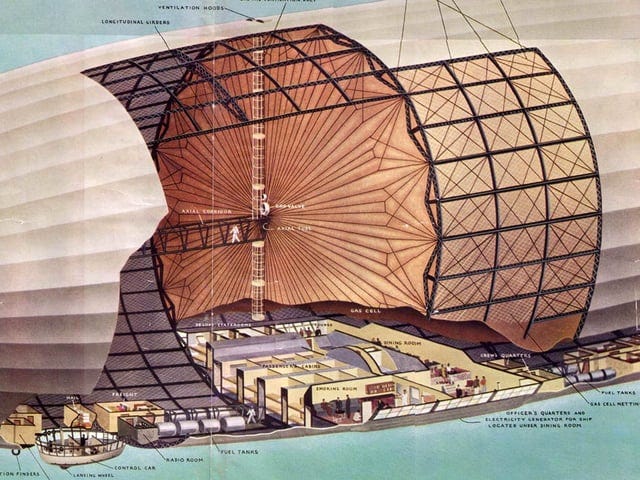



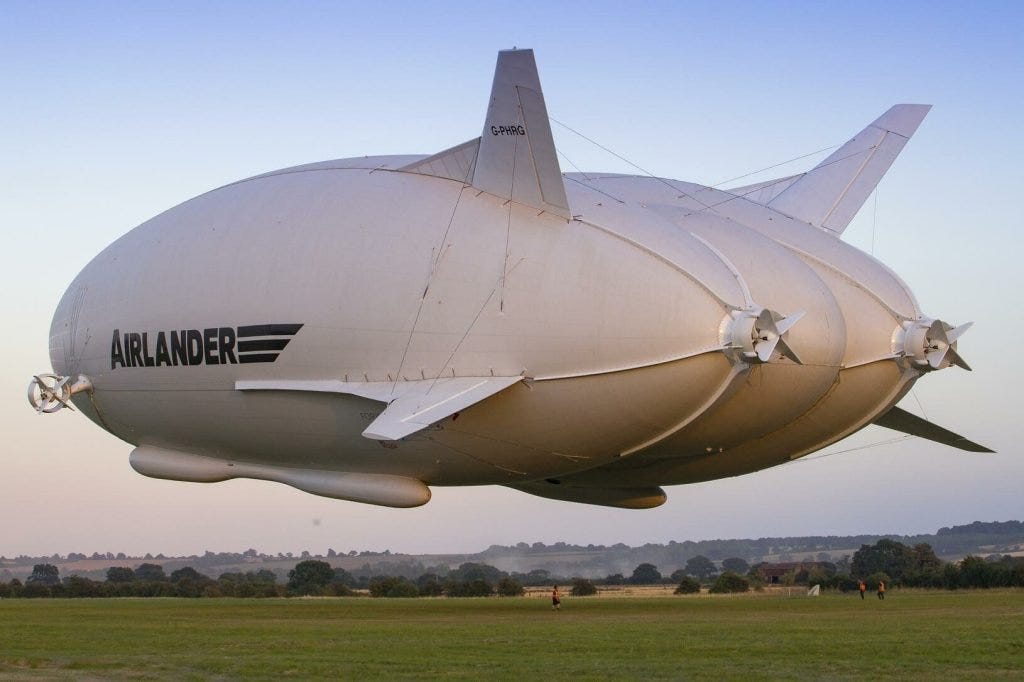
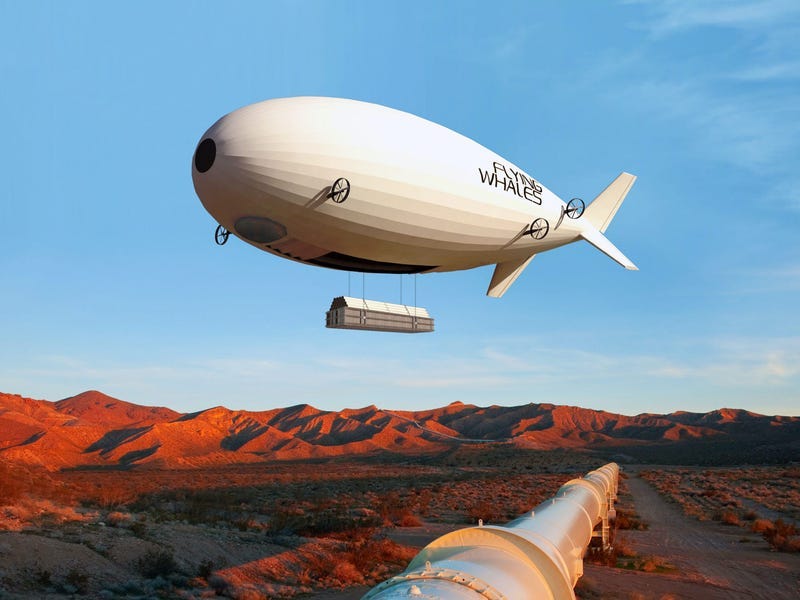
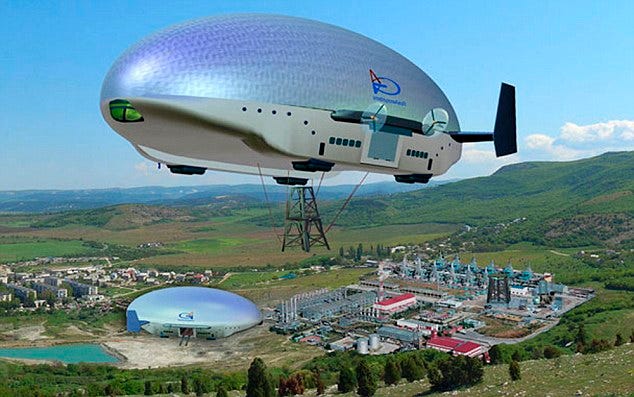
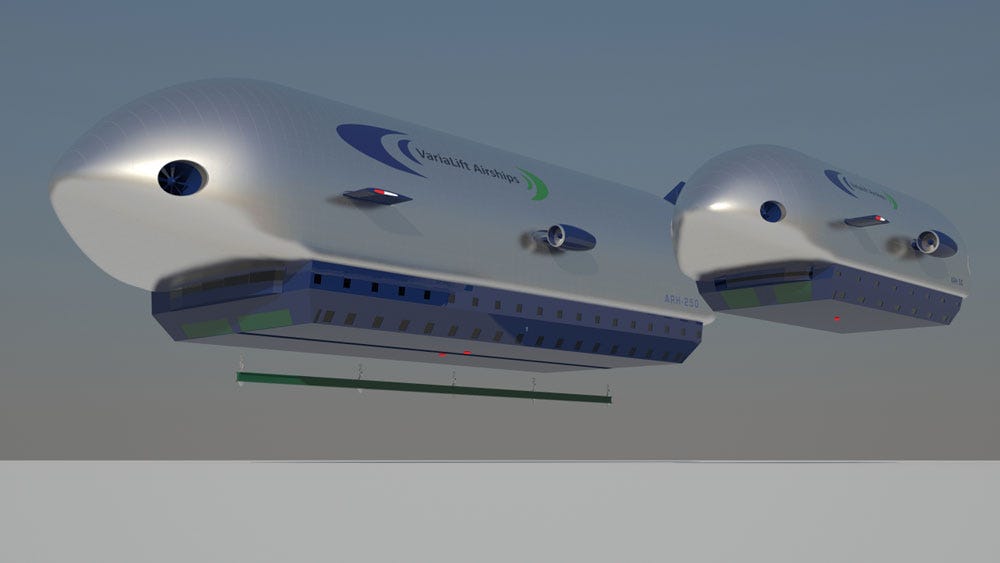




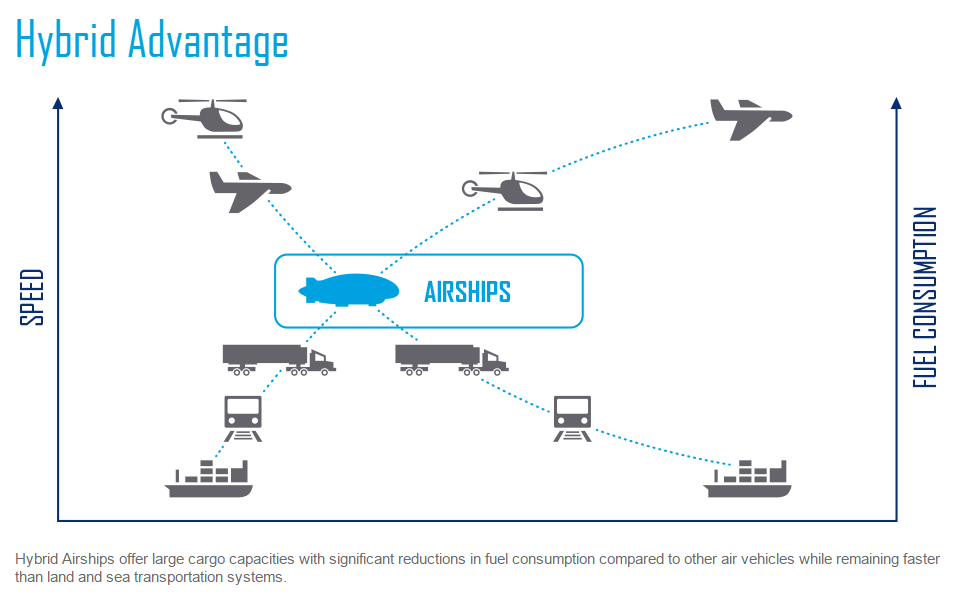
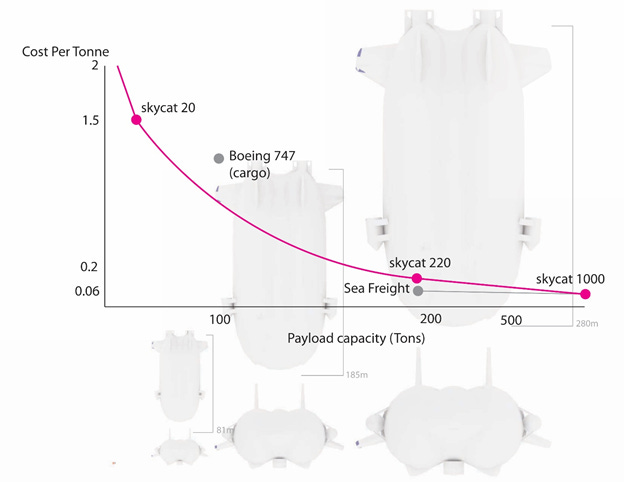



This is your magnum opus
When I lived on the coast in Tillamook county, Oregon, an aeronautics company developed an unusual take on an airship they called the Cyclocrane. Its purpose was to lift timber from the rugged terrain of steep hills and dense forests. To hear one flying by was odd, almost like an air show as the four engines climbed and fell on the cyclical trip around the craft. Brilliant idea, unfortunately due to the high winds (winters typically hit 90 - 100 mph gusts) their prototype got smashed and they never recovered.
https://en.wikipedia.org/wiki/AeroLift_CycloCrane